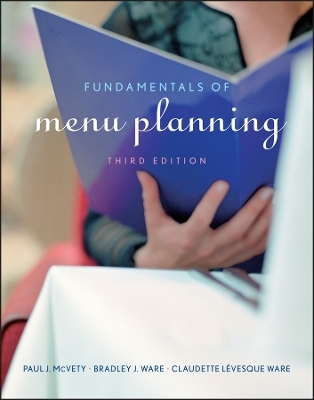
Fundamentals of Menu Planning
John Wiley & Sons Inc (Verlag)
978-0-470-07267-7 (ISBN)
- Titel z.Zt. nicht lieferbar
- Versandkostenfrei
- Auch auf Rechnung
- Artikel merken
Understanding the fundamentals of menu planning is essential to building a successful foodservice concept since the menu is the foundation upon which a foodservice operation builds both its reputation and profit. Reflecting the latest menu trends in the restaurant industry, the authors show how research, surveys, and sales analysis are key to menu planning and design.Fundamentals of Menu Planning, Third Edition presents a complete overview of key aspects of menu planning, including designing, writing, costing, marketing, and merchandising a menu. The content in this edition is divided into three parts. Part I focuses on the evolution of the menu and includes topics such as menu trends in the industry, performing market research and creating a market survey, nutrition and dietary guidelines, and menu planning. Part II examines the financial aspects of menu planning such as performing a yield test, creating and writing standardized recipes, and recipe costing. Part III covers writing, designing, and merchandising the menu. With this accessible resource, hospitality management students, culinary students, restaurateurs and other foodservice professionals will all gain a thorough understanding of how an effective and successfully planned menu is fundamental to the success and profitability of the wider foodservice enterprise.
Paul J. McVety is Dean of Culinary Academics at Johnson & Wales University in Providence, Rhode Island. BRADLEY J. WARE is a Professor in the College of Culinary Arts at Johnson & Wales University in Providence, Rhode Island. CLAUDETTE LéVESQUE WARE is a Professor in the John Hazen White School of Arts and Sciences at Johnson & Wales University in Providence, Rhode Island.
Preface xi
Part 1 Evolution of the Menu 1
Chapter 1 New Trends in the Foodservice Industry 3
Foodservice Trends 4
Appetizers 5
Soups 7
Salads 8
Sandwiches 9
Entrées 10
Accompaniments 17
Desserts 18
Beverages 19
Tea Menus 21
For Review and Discussion 21
Chapter 2 Market Survey 23
Preliminary Steps 24
Areas of Analysis 24
For Review and Discussion 36
Chapter 3 Nutrition and Menu Planning 37
Nutrition Basics 38
Phytochemicals 42
Guidelines and Recommendations for Meeting Nutrient Needs 43
Food Pyramids 46
Other Food Guide Pyramids 49
Nutrition Labeling 49
Relationship of Nutrition to Health 54
Diabetes Type 1 and 2 56
Nutritional Implications for Menu Planning 56
Ingredients and Preparation 57
For Review and Discussion 60
Chapter 4 Foodservice Menus 61
Menu Styles 62
Breakfast Menus 62
Brunch Menus 63
Luncheon Menus 63
Dinner Menus 72
Tasting Menus 72
Special Occasion Menus 73
Ethnic Menus 73
Specialty Menus 78
Catering Menus 79
Room Service Menus 86
Institutional Menus 86
Wine Menus 88
Dessert Menus 88
Tea Menus 90
Lounge Menus 95
For Review and Discussion 95
Part 2 Financial Aspects of Menu Planning 97
Chapter 5 The Yield Test 99
Defining the Yield Test 100
Types of Yield Tests 101
Calculating a Yield Test 103
Edible Yields Percentage 106
Software Packages 110
For Review and Discussion 110
Chapter 6 Standard Recipes 111
Defining Standard Recipes in the Industry 112
Recording Recipes 113
Recipe Creativity 114
For Review and Discussion 116
Chapter 7 Recipe Costing 117
Assigning the Task of Recipe Costing 118
The Importance of Recipe Costing 118
Guidelines for Costing Out a Recipe 120
How to Cost Out a Recipe 121
Recipe Costing Software 129
For Review and Discussion 132
Part 3 Writing, Designing, and Merchandising the Menu 133
Chapter 8 Characteristics of a Menu 135
Issues for Consideration 136
Paper 136
Print 137
Color 140
Balance 140
Variety 143
Composition 147
Descriptive Copy 147
Truth-in-Menu 149
Menu Labeling 151
Listing of Items 152
Size of Menu 153
Cover Design 153
Menu Design Software 153
For Review and Discussion 154
Chapter 9 Sales History 155
Sales History Background 156
Benefits of the Scatter Sheet 158
How a Scatter Sheet Works 159
Production Sheet 159
Menu Engineering 161
Software Programs Available 162
For Review and Discussion 163
Chapter 10 Merchandising the Menu 165
Displaying Additional Information on the Menu 166
Listing Liquors 167
Wine Lists 167
Appetizers 167
Salads 170
Steaks 172
Seafood 172
Sandwiches 172
Specials 176
Desserts 176
Take-Out Service 176
Evaluating the Sales Menu 176
For Review and Discussion 181
Chapter 11 Foodservice Equipment Analysis 183
Guidelines for Selecting Equipment 184
Selecting Equipment with Advanced Technology 188
Foodservice Equipment Analysis 189
Guidelines for Designing a Hot Cooking Line 193
For Review and Discussion 195
Appendix A Descriptive Copy Exercise 197
Appendix B Descriptive Terms for Menus 200
Appendix C Words Frequently Misspelled on Students’ menus 201
Appendix D Culinary Terms 202
Appendix E Measurements 209
Appendix F A Practical Guide to the Nutrition Labeling Laws for the Restaurant Industry 210
Appendix G National Restaurant Association’s Accuracy in Menus 232
Appendix H Menu Marketing Characteristics 239
Appendix I Menu-Making Principles 240
Bibliography 243
Index 247
| Zusatzinfo | Photos: 37 B&W, 0 Color; Drawings: 23 B&W, 0 Color |
|---|---|
| Verlagsort | New York |
| Sprache | englisch |
| Maße | 211 x 272 mm |
| Gewicht | 522 g |
| Themenwelt | Wirtschaft |
| Weitere Fachgebiete ► Handwerk | |
| ISBN-10 | 0-470-07267-9 / 0470072679 |
| ISBN-13 | 978-0-470-07267-7 / 9780470072677 |
| Zustand | Neuware |
| Haben Sie eine Frage zum Produkt? |
aus dem Bereich


